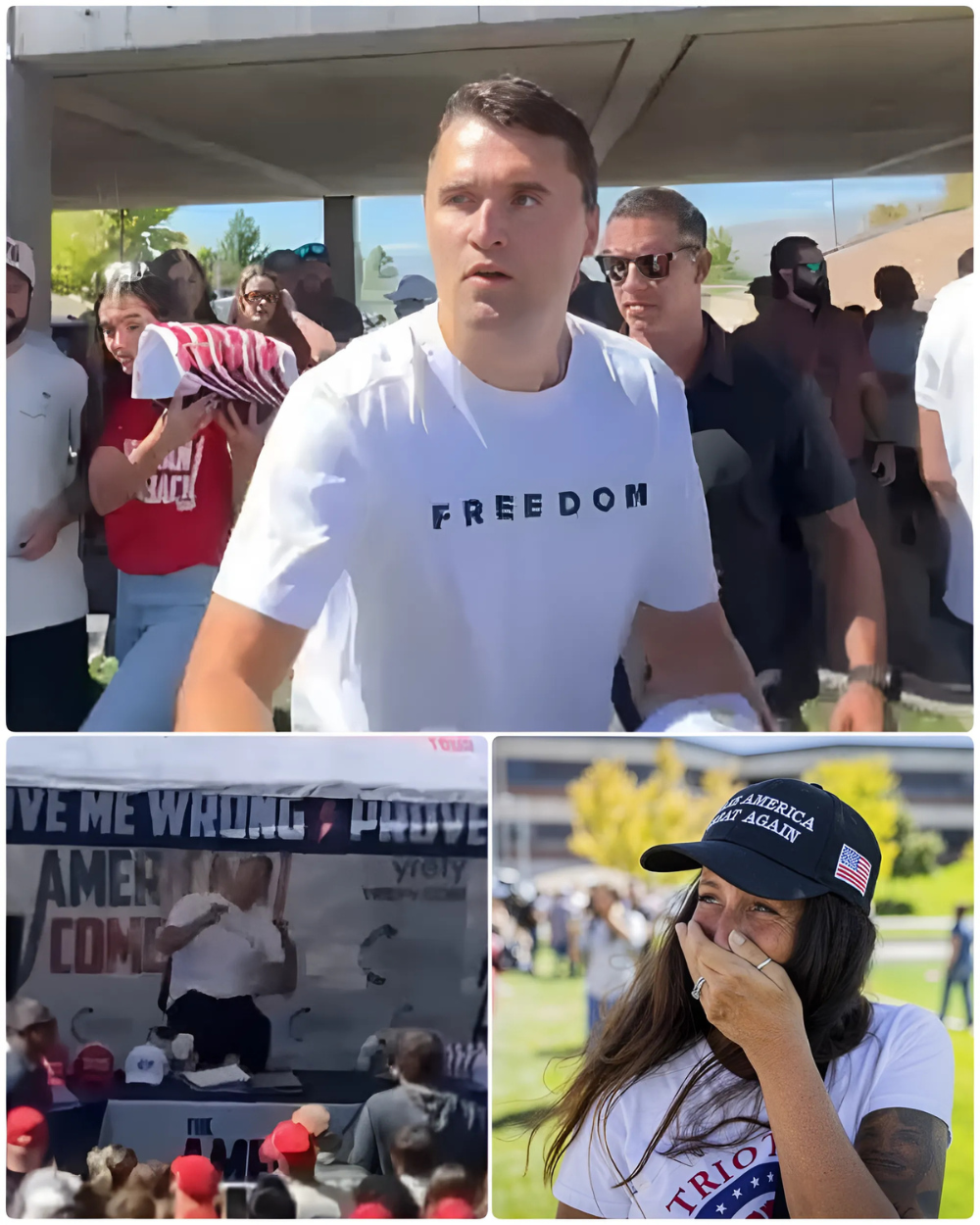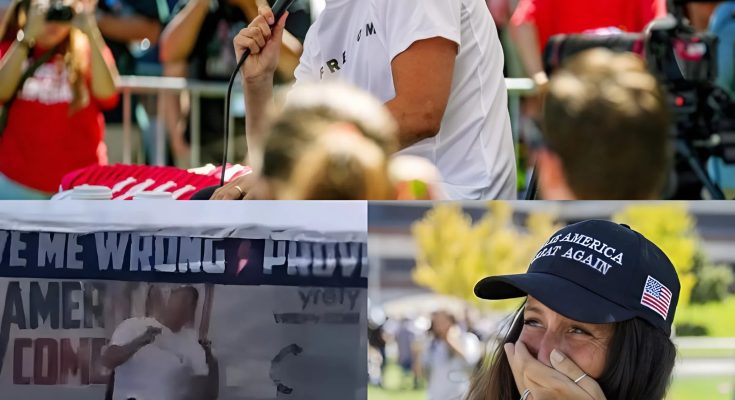
Utah Valley Shaken: Charlie Kirk Collapses on Stage — What a Close Aide and Witness Said Made Everything Feel Drowned in Despair

It was supposed to be the triumphant kickoff of Charlie Kirk’s much-anticipated American Comeback Tour. The setting was Utah Valley University’s Sorensen Center courtyard, decorated with banners reading The American Comeback and Prove Me Wrong. A white tent framed the stage. Hundreds of students, activists, and onlookers packed the space, eager to see one of the most visible conservative voices in America.
The afternoon sun filtered through the fabric canopy, highlighting Kirk as he spoke into a handheld microphone, gesturing, pausing, leaning forward to emphasize each point. The audience listened, some cheering, others frowning, but all aware they were watching a figure who had sparked controversy nationwide.
Then, in a single, jarring instant, the atmosphere shattered.
The Moment Everything Changed
Witnesses describe hearing a sharp sound, unmistakable, echoing across the courtyard. At first, some thought it was a microphone glitch, a speaker crackling. But within a breath, the mood shifted. Gasps, screams, and then silence as eyes turned toward the stage.
Charlie Kirk’s body recoiled, his right hand instinctively reaching for his neck. His voice cut off mid-sentence. He stumbled, visibly unsteady, and for a moment the stage itself seemed frozen.
Sophie Anderson, 45, standing nearly a hundred feet away, recalled: “The second it happened, I knew what it was. He just fell, and suddenly everything was chaos. People screamed, some started to run, others froze. It was like watching the world tilt.”
Nearby students ducked for cover. Others sprinted toward exits, colliding, dropping belongings, grabbing friends by the arms. One witness described the moment as “a wave of panic that rolled through the courtyard.”
A Close Aide’s Terrifying Words
As Kirk was rushed offstage by members of his security team, a close aide reportedly whispered to reporters and organizers huddled nearby. His voice cracked, his face pale.
“It’s not stable… he’s not stable.”
Those words spread quickly among those present, repeated in frightened tones: “not stable.” The aide refused to say more, holding his head in his hands as paramedics moved in.
The phrase was enough to chill the gathering further. Attendees had already been shaken by the sudden collapse, but now the suggestion of an “unstable condition” deepened the sense of dread.
Witness Accounts of Despair
Justin Hickens, a student who said he stood less than twenty yards from the stage, recalled seeing Kirk falter:
“I heard the sound, and then I saw him jolt back. He just went limp for a moment, and everyone dropped to the ground. Then there was shouting, people crying, and I realized it wasn’t a drill, it wasn’t theater — it was real. The word people started saying was ‘despair.’ That’s what it felt like. Like no way out.”
Others described the moment in hushed tones, still processing what they had seen. One young woman who asked not to be named said: “It was like a curtain fell. We went from clapping to screaming to silence in less than a minute. When someone said he might not make it, I couldn’t breathe.”
Panic on Campus
The courtyard emptied in waves. Students sprinted across lawns and hallways, trying to find exits. Some were separated from friends and later reunited in tears. Faculty members ushered people into classrooms and locked doors.
The university immediately issued alerts: “Campus closed. Classes canceled until further notice. Police investigating. Leave campus immediately. Follow police instructions.”
Law enforcement confirmed that a suspect was taken into custody. The arrest unfolded dramatically, with video showing officers restraining an older man with white hair as he shouted, “I have the right to remain silent!” His trousers appeared loose, his voice rising in defiance even as he was led away.
Authorities later revealed that the shot appeared to have come from the Losee Center, a building roughly 200 yards away from the courtyard. Investigators believe the suspect had positioned himself on an upper floor.
A Scene Frozen in Time
Photos and video quickly spread online, showing the stunned aftermath: chairs overturned, banners flapping in the breeze, students huddled in corners. Some images captured the exact moment Kirk was struck, his hand pressed against his neck, his microphone slipping.
Allison Hemingway-Witty, a local resident who attended with friends, broke down in tears moments later. “We thought we were just going to a campus talk. Then suddenly we were running for our lives. I still can’t believe it.”
For many present, the silence after the shot was worse than the noise. The weight of not knowing, of seeing Kirk carried away, left them trembling.
Authorities React
Utah Governor Spencer Cox issued a statement condemning the violence: “Those responsible will be held fully accountable. Violence has no place in our public life. Our prayers are with Charlie, his family, and all those affected.”
California Governor Gavin Newsom, often politically opposed to Kirk, nonetheless expressed outrage: “In the United States of America, we must reject political violence in every form. What happened in Utah is vile and reprehensible.”
Robert F. Kennedy Jr., current Health Secretary, wrote on X: “We love you Charlie Kirk. Praying for you.”
Even as the words of support poured in, law enforcement remained tight-lipped about the details of Kirk’s condition. The only consistent description was that his state was “serious” and that doctors were “still working.”
University in Shock
By evening, Utah Valley University’s campus remained shut down. Police cordoned off multiple buildings. Students were told to stay home until further notice.
Ellen Treanor, a university spokesperson, confirmed: “Today at about 12:10 a shot was fired at the visiting speaker, Charlie Kirk. He was taken from the location by his security. Police are investigating, and a suspect is in custody.”
She added: “We know many are shaken. Counselors will be available for students and staff.”
Social Media Storm
Clips of the incident exploded across platforms within minutes. Some showed Kirk speaking, pausing, and then collapsing. Others showed students sprinting, crying, or yelling at the suspect as police escorted him away.
“How dare you, you monster!” one voice screamed in a video replayed thousands of times.
Hashtags like #PrayForCharlie, #UtahValley, and #CampusChaos trended nationwide. Supporters begged for updates. Critics, meanwhile, debated the dangers of political polarization spilling into violence.
One student tweeted: “We were here for a lecture, not a tragedy. I can’t stop hearing the sound.” Another wrote: “The scariest part is the silence after. Hundreds of us just staring, waiting for someone to say he’s okay.”
The Aide’s Haunting Phrase
By nightfall, the phrase whispered by Kirk’s aide — “not stable” — had taken on a life of its own. Repeated in headlines, echoed in posts, dissected by commentators, it symbolized the uncertainty that gripped everyone who had seen the event unfold.
Doctors at a nearby hospital did not release specifics, but multiple sources confirmed he had “lost a significant amount of blood” and was in “critical care.”
Still, no one dared declare his outlook. Every update ended with the same refrain: “Doctors are still working.”
Political Tensions Already High
The Utah stop had been preceded by controversy. More than 7,000 people signed a petition urging the university to ban Kirk from appearing, citing his outspoken views. The administration allowed the event, citing free speech protections.
That decision now sits under fierce scrutiny. Parents demanded answers about security. Students questioned why a potentially polarizing speaker was brought onto campus without greater precautions.
Phil Lyman, a former Utah state representative who had been on stage minutes before the collapse, told reporters: “This was supposed to be about ideas. No one imagined it would turn into this.”
A Nation Divided, A Campus in Mourning
Across the country, reactions split along familiar lines. Supporters decried the attack as proof that conservative voices are under siege. Detractors pointed to the risks of incendiary rhetoric. Yet in the immediate aftermath, the raw emotion transcended politics.
Students lit candles outside the Sorensen Center. Handwritten notes appeared on poster boards: “Stay strong Charlie.” “We’re with you.” “Please come back.”
One faculty member said quietly: “We can disagree on ideas, but what happened here today was a tragedy for everyone.”
Closing on the Witness Words
As the night deepened and the campus emptied, one witness summed up the feeling lingering in the air:
“We walked in clapping, we walked out in silence. Nobody knows what tomorrow brings. All we know is that it felt like despair.”
For now, America waits — for updates from doctors, for clarity from investigators, for reassurance that the moment that froze Utah Valley will not define the future of one of the country’s most polarizing figures.
Until then, the memory remains: a stage, a sudden collapse, a whisper of instability, and a crowd that will never forget the sound of silence.



